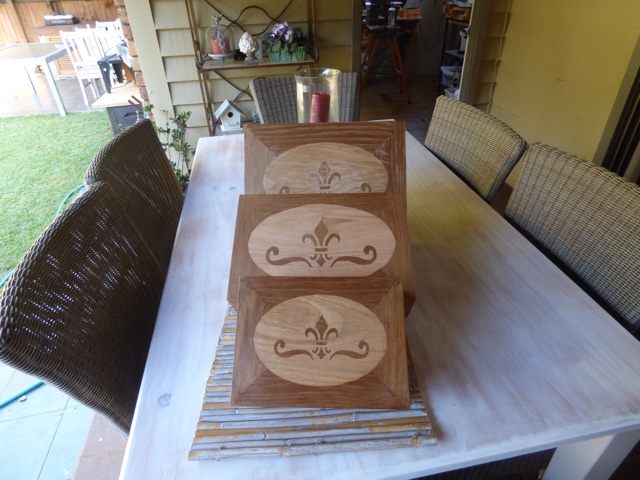Somewhere on the wonderful world of GOOGLE I once read that:
"Anyone can do woodwork, but a craftsman is someone who has taken the time to learn how to cover there mistakes." don't know who by but full credit to them.
When you think about it this is very true, I have done a lot of woodwork and seen a lot of woodwork done over the years and in all this time I can't remember any project I've done or seen done without making a mistake, my wife in the quilting world said that only god is perfect so all quilts are made with a mistake still evident. That's my philosophy for today which leads me to today's post.
In my last post I explained how I make wood hinges, I am currently working on a nest of three boxes all the same but varying sizes. With the marquetry for the top of the largest box I have struck a major problem, I glued the panel to the top of the box pressed
and clamped it into position and left it to dry in the same manner as i usually do. But when I opened it the veneer immediately started to lift and crinkle as a sheet of paper does when to much glue is used. I have know idea why, it maybe that this is the largest area that I have covered at one time, maybe the larger area required longer for the glue to set, maybe it is because the humidity was to high. I will do some experimentation to find out but for the time being what am I going to do.
Knowing from past experience that if you cote both surfaces with PVA glue and allowing to dry, then by the use of a hot iron Iron the two parts together. So I decided to cover the surface with nonstick cooking paper and a sheet of printer paper then with a very hot I slowly ironed and smoothed the surface In the hope that the heat would first course the veneer to shrink, also dry any excess moisture and thirdly the heat would reactivate the glue.
This all worked really well except it left the surface quite rough and uneven, so with a number of home made scrapers set for a progressively finer finish.
I was able to cut the surface back until smooth.
I an quite happy with the result, if anyone out in eland has any other ideas or suggestions or has any idea of why this has happened I'd love to hear from you.
Thanks to all for taking the time and showing an interest in my work.
"Anyone can do woodwork, but a craftsman is someone who has taken the time to learn how to cover there mistakes." don't know who by but full credit to them.
When you think about it this is very true, I have done a lot of woodwork and seen a lot of woodwork done over the years and in all this time I can't remember any project I've done or seen done without making a mistake, my wife in the quilting world said that only god is perfect so all quilts are made with a mistake still evident. That's my philosophy for today which leads me to today's post.
In my last post I explained how I make wood hinges, I am currently working on a nest of three boxes all the same but varying sizes. With the marquetry for the top of the largest box I have struck a major problem, I glued the panel to the top of the box pressed
and clamped it into position and left it to dry in the same manner as i usually do. But when I opened it the veneer immediately started to lift and crinkle as a sheet of paper does when to much glue is used. I have know idea why, it maybe that this is the largest area that I have covered at one time, maybe the larger area required longer for the glue to set, maybe it is because the humidity was to high. I will do some experimentation to find out but for the time being what am I going to do.
Knowing from past experience that if you cote both surfaces with PVA glue and allowing to dry, then by the use of a hot iron Iron the two parts together. So I decided to cover the surface with nonstick cooking paper and a sheet of printer paper then with a very hot I slowly ironed and smoothed the surface In the hope that the heat would first course the veneer to shrink, also dry any excess moisture and thirdly the heat would reactivate the glue.
This all worked really well except it left the surface quite rough and uneven, so with a number of home made scrapers set for a progressively finer finish.
I was able to cut the surface back until smooth.
I an quite happy with the result, if anyone out in eland has any other ideas or suggestions or has any idea of why this has happened I'd love to hear from you.
Thanks to all for taking the time and showing an interest in my work.







No comments:
Post a Comment